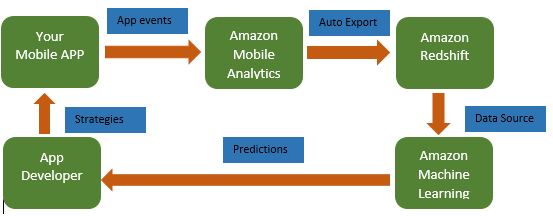Front-End Web & Mobile
Using Amazon Machine Learning and Amazon Mobile Analytics to build predictive applications for your mobile app
Update: April 30, 2018: We’ve discontinued Amazon Mobile Analytics. Amazon Pinpoint now provides the analytics features that Amazon Mobile Analytics previously offered. If you’re new to Mobile Analytics, you can integrate the mobile analytics features of Amazon Pinpoint into your app. If you currently use Amazon Mobile Analytics, you can migrate to Amazon Pinpoint.
Using data to make informed decisions is critical to maximizing your mobile app business. Many large app and game developers have used analytics and machine learning to enormous benefit. For example, using a strategy as simple as predicting users who have a high risk of attrition in a mobile app or game and re-engaging them by sending push notifications can have significant impact on user retention. However, developers were required to understand complex algorithms or hire a data science team in order to build machine learning applications for their mobile apps. Now there are tools all mobile developers can use to fully leverage their analytics data to increase app engagement and monetization. In today’s blog post, I will cover how mobile developers can leverage Amazon Mobile Analytics and a new service, Amazon Machine Learning (Amazon ML), to build machine learning (ML) models easily.
Amazon ML allows developers to build predictive applications and machine learning models by finding patterns in existing data, and using those patterns to make predictions from new data as it becomes available. Amazon ML provides visualization tools and wizards that guide you through the process of creating machine learning models so you do not need to write additional code. You can use the Amazon Mobile Analytics Auto Export feature to collect and automatically export app event data to Amazon Redshift. Amazon ML can use an Amazon Redshift as a data source to train an ML model. Once the data source creation is completed, you are few clicks away from building your first machine learning application for the mobile app.
Click here to learn more about Amazon ML and here to step through a tutorial on how to build predictive applications using Amazon ML. Click here for information about how to turn on the Amazon Mobile Analytics Auto Export feature.

This simple architecture allows developers to build scalable predictive algorithms catering to the unique needs of your app or game. The following are sample use cases which can be easily built but can have a significant impact on app’s engagement and monetizarion:
- Predict customers who are at risk of attrition from the app or game and send push notifications to re-engage them
- Predict customers who have never made an in-app purchase, but have a strong propensity to make one, and use in-app messaging to convert them to paying users
- Predict customers who have a high probability to share the app through social media or recommend to a friend and proactively prompt them to do the same
- Predict based on customer’s in app behavior if unlocking certain levels/challenges in the game or particular features in the mobile app increases retention/monetization
Conclusion:
Building predictive applications and using machine learning differentiates your app or game from the rest. It also helps you better engage users. With the Amazon Mobile Analytics Auto Export feature, now you can export app events to Amazon Redshift and use this data to build machine learning applications with Amazon ML. I hope this blog will encourage you to build your first predictive application. Feel free to post questions or suggestions in the comments or in our forum.